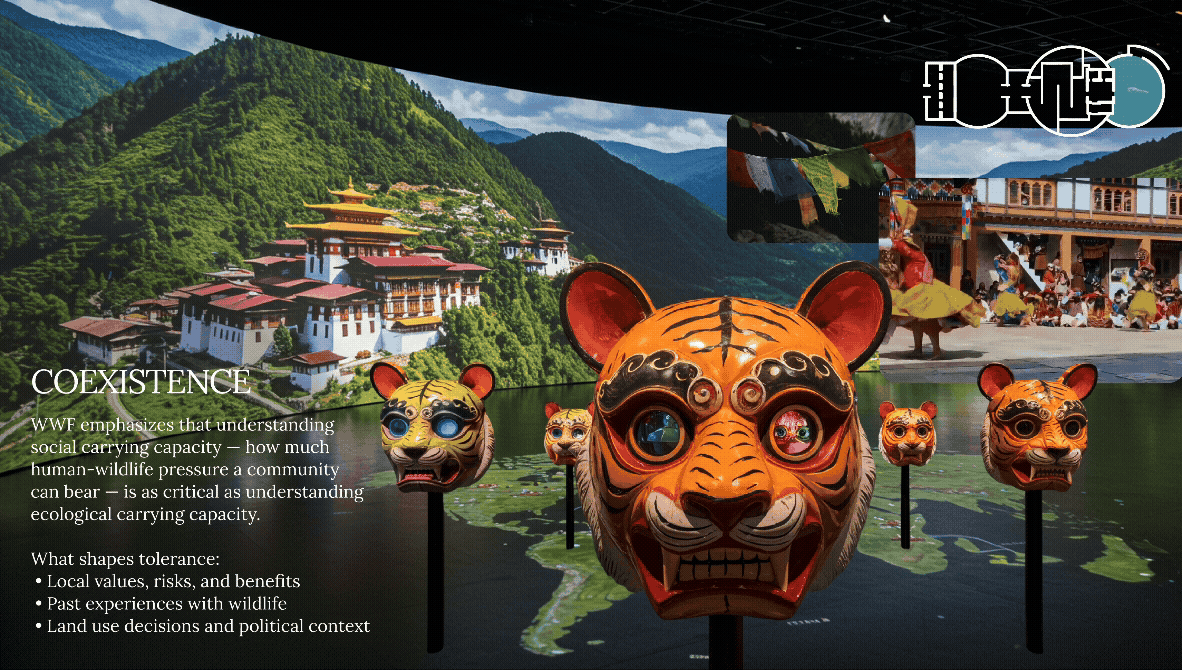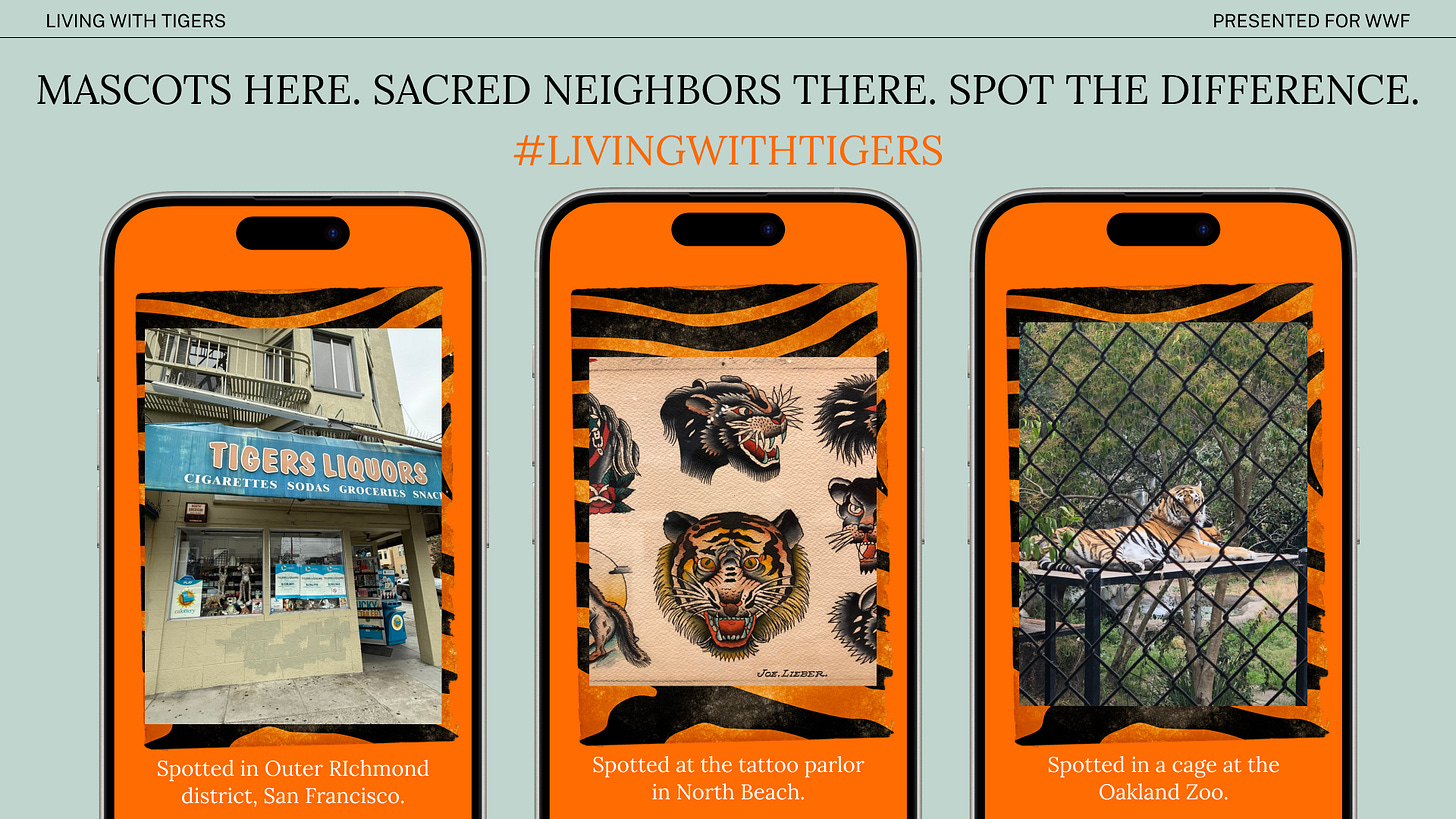I’m on an odyssey to expand my experience design practice through a year long residency program and sharing my project work here on Freelance for Life.
If you missed my announcement you can learn more about that here:
What does it mean to live with tigers?
Not in stories, but as neighbors?
To lose sleep over livestock?
To bury a neighbor after an attack?
To teach your children both reverence and fear?
These were the questions at the heart of my final spring semester project, a collaboration with WWF’s Tigers Alive initiative. While many of us are familiar with conservation efforts like wolf reintroduction in Yellowstone, few of us truly understand what our global neighbors in Bhutan face—not in protected parks, but in their own backyards.
In Bhutan’s Trongsa region, conservation efforts have helped tiger populations recover, but as numbers grow, so do human-wildlife conflicts. Livestock disappear. Families grieve. Economic hardship grows. Reverence and tolerance are tested.
WWF asked us to design an experience that would help global audiences not only understand human:tiger conflict but truly feel its impact—and be inspired to take action.
Designing the “Living With Tigers” exhibit
Ask anyone on the street what comes to mind when they hear "tiger," and you'll likely hear:
Fierce, Majestic, Stripes.
Maybe even Tony the Tiger. 🐯
But in WWF’s interviews with Bhutanese villagers, the vocabulary was different:
Fear. Loss. Reverence. Resignation. Coexistence.
This tension—between symbolic fantasy and lived reality—became the foundation for our exhibit.
We asked ourselves: how do you design a museum experience that holds both conservation and culture, awe and grief, beauty and burden?
We titled our exhibit Living With Tigers—a traveling, immersive experience built to shift understanding and mobilize support for Bhutan’s human:tiger conflict.
Our solution was a multi-room sensory journey that transforms perspectives, helping visitors understand tigers not just as symbols, but as neighbors in our shared world.
I collaborated with two extraordinary designers on this project:
Melissa Carine – a museum program manager who led programming strategy and audience engagement
Valerie Sherry Caruolo – an architect who led spatial design and environmental layout
As the visual storyteller, I shaped the exhibit’s emotional arc through concept development across both digital and environmental design. I originated and designed key spatial touchpoints—from the souvenir shop and cultural mask stations to the interactive floor map and projection-mapped video stories. Using digital collages, prototyping, and AI-assisted mockups, I brought each space’s atmosphere and interactions to life.
Key components of our exhibition include:
Immersive world building
Interactive and educational installations
Oral storytelling through film and audio materials from Bhutanese villagers (created by WWF)
Immersive projection mapping with editorial content and UGC
Interactive kiosk and map for mutual guardianship pledges & donations
Native mobile app and social marketing experience for UGC and global participation
🛍 Enter through the gift shop


Visitors begin in a Tiger Souvenir Shop—a space deliberately designed to feel familiar and playful. Shelves overflow with tiger-branded merchandise: cereal boxes, sneakers, sports jerseys, and stuffed animals, while screens display clips of commercials, sports events, and fashion shows featuring tiger-themed products.
This entry point highlights how commercialized and distant our relationship with tigers has become, setting up a powerful contrast for the more authentic encounters ahead.
“Symbols of tigers are everywhere: embroidered jackets, restaurant logos, laptop stickers, book covers. Our visual culture is saturated with tiger substitutes that allow us to marvel at the species’ beauty without the inconvenience of confronting their ferocity.”
- Aditi Natasha Kini, “Tiger- A Gross History Of A Cultural Fascination”
Woven into this space is a subtle question: what happens when a symbol overshadows the living being it represents?
🌲 Into the tiger’s territory
From the shop, visitors move into a shadowy corridor that leads them further into a dense and winding forest. The air grows thick with tension as darkness limits visibility to just a few feet ahead. Immersive forest sounds surround you—branches snapping, leaves crunching underfoot.
Moving through the space, visitors learn about tigers' remarkable abilities: their panoramic night vision, acute sense of smell, and imposing physical presence. Life-size silhouettes help visitors grasp the true scale of these magnificent predators. The forest canopy presses overhead while filtered light creates dappled shadows, heightening one's sense of vulnerability in tiger territory.
Using principles of neuroaesthetics, the space triggers physiological responses—elevated heart rate, heightened senses, increased alertness. This visceral experience helps visitors understand both the awe-inspiring power of tigers and the very real challenges of living alongside them.
🏠 Inside a Trongsa home
The forest path leads visitors into a re-creation of a Bhutanese farmhouse belonging to Pema, a young woman from Trongsa whose family has repeatedly lost livestock to tigers.
Inside, visitors encounter handmade furnishings and layered projections of Pema and her village neighbors' struggles. A home altar shrine tells of tigers’ spiritual significance in Bhutan—adding a dimension that reveals further complexity to this relationship.
"Tiger, our forefather. Tigers have always roamed our lands. Our ancestors called them our guardians… We have always respected them as our guardians. But when they take away our livelihood, it is very frustrating." - Nidup Dorji
Through open windows that look out toward the forest, growls echo and shadows lurk. The tiger's presence remains visceral here.
"I don't see a way forward, the problem is here to stay. Tigers have to live in the forest, we have to live in our village." - Pema Choden
This room is the emotional heart of the exhibit.
It doesn’t ask you to take a side. It invites you to sit inside the complexity.
(Videoclips © WWF)
🌍 A space for hope
Visitors exit Pema's home into a rounded, immersive room of community. This space ends the exhibition with a collective offering—equal parts call to action and place of reflection and hope.
This space features multiple immersive elements and engagement zones:
On the walls, projected scenes showcase the stunning Bhutanese landscape and additional stories from community members.
Through Bhutanese masks, visitors can watch cultural vignettes, including Religious Mask Dance festivals and monks painting tigers on the walls of Paro Taktsang ("Tiger's Nest" temple).
An interactive kiosk system allows visitors to learn about community conservation policy and programs for tiger monitoring, mitigation, prevention, and response.
On the floor, an interactive world map illuminates with each visitor's donation, as sound reverberates through the room—creating a shared celebration of giving.
Bridging perspectives
This exhibit was more than a design challenge. It was an emotional, cultural, and strategic inquiry into what it means to live with other species—and to design experiences that help others feel that, too.
The goal wasn’t to cast tigers as villains or humans as victims. It was to widen the frame, to help people feel what coexistence actually costs.
Outcomes we envisioned:
Expanding public awareness of human-wildlife conflict beyond traditional conservation messaging
Blending storytelling with spatial design to deepen empathy and financial support from audiences of all ages
Digital marketing campaign for awareness and donation
Partnering with tiger-branded companies to generate funding and visibility
Creating a replicable model for other human–wildlife conflict stories globally
The art of immersive storytelling
As an experience designer, I believe story and space are inseparable—this project exemplified my passion for creating environments where meaningful encounters resonate both emotionally and intellectually. Through careful choreography of space, sound, and interaction, we crafted a journey that bridges cultural divides and transforms perspectives.
Key takeaways:
🏗️ Narrative architecture matters
Every spatial decision—location, shape, pacing, tension, release—can serve the emotional arc of a story.
👂 Multi-sensory design creates lasting engagement
Sound, light, texture, and visual aesthetics engage more than just the intellect. They bring experiences to life, creating deeper emotional connections and making memorable impressions that we feel long after we leave.
🤝 Cultural authenticity requires collaboration
By working with WWF's oral histories, architectural cues, and Bhutanese cultural motifs, we ensured the experience was resonant, not reductive. Our team's diverse expertise - from museum programming to architecture to visual storytelling - created a richer, more nuanced experience that honored both the cultural and technical complexity of the project.
This journey has deepened my love for crafting experiences that don't just inform, but transform—where every shadow, sound, and step becomes part of a larger story of connection and understanding.
🐯 🐅 🐯 🐅 🐯 🐅 🐯 🐅 🐯 🐅 🐯 🐅 🐯 🐅
The next time you see a tiger logo—on a cereal box, sneaker, or t-shirt—pause for a moment.
Consider the living animal behind the symbol.
The people who share land with it.
The cultures shaped by both reverence and risk.
There are no tiger mascots without tigers.
And no true coexistence without care.
If you’re compelled to donate to the WWF Tiger Alive initative you can learn more here.
💬 I’d love to hear your thoughts: Have you ever visited a museum exhibit that stayed with you?














Wow! This exhibit is so cool! I loved the immersive experience, I think learning more about the tiger in their habitat, hearing the stories of those in the village that have to live alongside the tigers, as well as thoughts on coexistence were especially powerful and likely perspectives that most of us have not heard before. Making intentional space for these perspectives too helps to make sure that we have time to really think about each in isolation.
Visiting the 9/11 museum core exhibition remains one of the more memorable experiences I’ve had with an exhibit. I was in New York during 9/11, but remember it mostly from a child’s perspective and the worry that came along with it for my friends and family. Visiting the museum as an adult brought me back in a different way. I really felt for everyone in the trade center and I was starting out in finance at the time, so hearing the stories of those with similar backgrounds to me at that stage, just starting their finance career at Cantor Fitzgerald, and then their lives being cut short at such a young age really stuck with me. Seeing the name of someone I knew on the wall, the artifacts from the time and the news coverage did as well. They really tried hard to make it so you could feel the emotions and experiences of that day and the days that followed through a multisensory experience.
https://911memorial.org/visit/museum/Exhibitions/historical-exhibition-september-11-2001
Immersive experiences like yours are powerful and make it so that we can come in multiple times and see things from new perspectives and with new eyes. So cool to see you engaged in such meaningful work 😊🫶